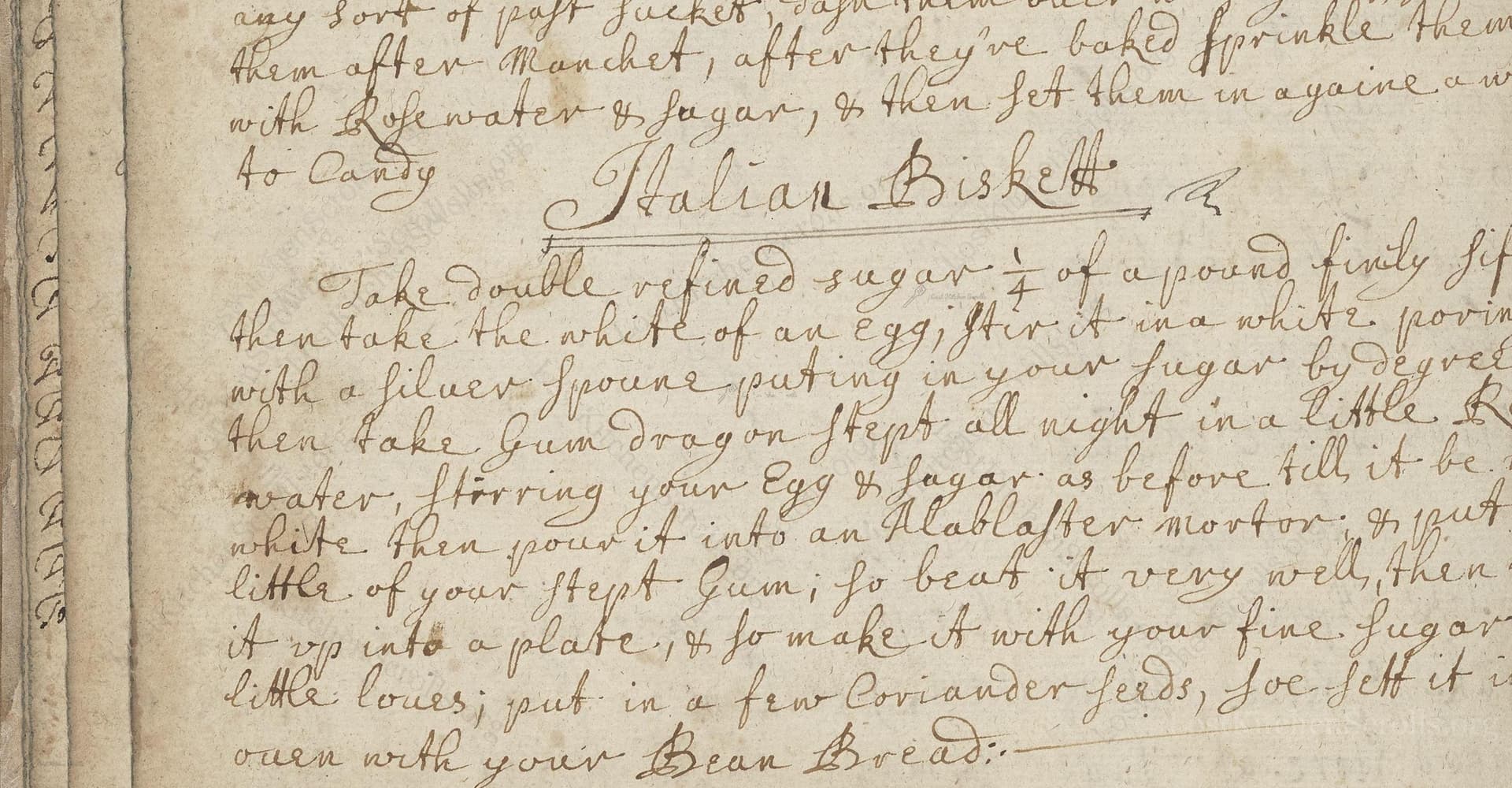Italian Biskett
From the treasured pages of Cookbook of Jane Dawson
Written by Jane Dawson

Italian Biskett
"Take double refind Sugar ¼ of a pound finely Sifted, then take the white of an Egg, Stirr it in a white poringer, putting in your Sugar by Degrees, then take Gum Dragant well Steept all night in a little Rose water, Stirring your Egg & Sugar as before till it be very white, then pour it into an Alablafter mortar, & put in a little of your Stept Gum; So beate it very well, then take it up into a plate, & So make it with your fine Sugar into little loaves; put in a few Coriander Seeds, &oe Sett it in an Ouen with your Bean Bread:."
Note on the Original Text
Seventeenth-century recipes were characteristically sparse on details, assuming the reader's know-how. 'Gum Dragant' refers to gum tragacanth, prized for its ability to firm up confections. Spelling and grammar varied widely: 'Steept' is soaked, 'Alablafter' is alabaster, 'Ouen' is oven, and 'loeaves' here means small loaves or shapes, not bread. Instructions relied on visual cues and touch ('very white', 'well beaten'), with quantities and timings often implied or entirely omitted. This recipe is a delightful example of early English sugarwork, echoing techniques that would eventually develop into modern meringues and sugar pastes.

Title
Cookbook of Jane Dawson (1690)
You can also click the book image above to peruse the original tome
Writer
Jane Dawson
Era
1690
Publisher
Unknown
Background
A delightful glimpse into late 17th-century English kitchens, Jane Dawson's recipe collection is a flavorful tapestry of sweet delicacies and savory dishes, revealing the tastes and ingenuity of bygone home cooks.
Kindly made available by
Folger Shakespeare Library
This recipe, titled 'Italian Biskett', hails from the late 17th century and comes from the manuscript collection of Jane Dawson, an Englishwoman whose household notebook reveals a fascination with the fashionable foods of her time. The 'biskett'—an early form of what we now call biscuit—was more of a meringue-like sweet, made not with flour but with egg white, sugar, aromatic rose water, and gum tragacanth. Such confections reflected both continental European (especially Italian) influences and the emerging English passion for sugarcraft. Recipes like this one would have graced the sweet tables of the well-to-do, evoking sophistication and novelty at a time when both sugar and exotic spices announced status.

Historically, the cook would have used a 'white porringer'—a shallow, small, earthenware bowl—for beating the egg white and mixing in the sugar, then an 'alabaster mortar' for pounding the final mixture to smoothness. Fine sieves were vital for sugar preparation, and careful handwork shaped the bisketts. Baking was done in a wood-fired oven, sometimes alongside 'Bean Bread', to take advantage of gentle, falling heat suitable for delicate sweets.
Prep Time
10 mins
Cook Time
1 hr
Servings
14
We've done our best to adapt this historical recipe for modern kitchens, but some details may still need refinement. We warmly welcome feedback from fellow cooks and culinary historians — your insights support the entire community!
Ingredients
- 4 ounces (¼ pound) white caster sugar, finely sifted
- 1 egg white (medium)
- 1/16 ounce (1 teaspoon) gum tragacanth (modern: food-grade gum tragacanth powder or substitute with 2 teaspoons xanthan gum gel if unavailable)
- 1/3 fluid ounce (2 teaspoons) rose water
- 12–16 whole coriander seeds
Instructions
- Begin by weighing out 4 ounces of finely sifted white sugar.
- Place the white of one medium egg into a mixing bowl and lightly beat it.
- Gradually add the sifted sugar, stirring smoothly until the mixture thickens and turns glossy.
- The next key ingredient is gum tragacanth—a natural thickener used in historical confectionery, still available today.
- Soak 1 teaspoon (about 1/16 ounce) of gum tragacanth overnight in 2 teaspoons (1/3 fluid ounce) of rose water to form a gel.
- Gently incorporate a small amount of this gel into the egg-sugar mixture, stirring well to create a thick, pale paste.
- Using a mortar (or a sturdy bowl) and pestle, beat the mixture thoroughly until it becomes satiny and firm.
- Transfer the paste to a plate and shape it into small loaf-like pieces, about the size of a walnut.
- Press a few coriander seeds into each loaf for aroma and decoration.
- Arrange the loaves on a lined baking sheet.
- Bake at a very low oven temperature (around 210°F/100°C) for 45 minutes to 1 hour, or until they are just set and dried but not browned—much like meringues today.
Estimated Calories
35 per serving
Cooking Estimates
It takes about 10 minutes to prepare and mix the ingredients, then about 1 hour to bake until the loaves are set and dried. Each piece is a small sweet treat, similar to a small meringue, and there are about 12-16 pieces in total. Each piece has roughly 35 calories.
As noted above, we have made our best effort to translate and adapt this historical recipe for modern kitchens, taking into account ingredients nowadays, cooking techniques, measurements, and so on. However, historical recipes often contain assumptions that require interpretation.
We'd love for anyone to help improve these adaptations. Community contributions are highly welcome. If you have suggestions, corrections, or cooking tips based on your experience with this recipe, please share them below.
Join the Discussion
Rate This Recipe
Dietary Preference
Main Ingredients
Culinary Technique

Den Bockfisch In Einer Fleisch Suppen Zu Kochen
This recipe hails from a German manuscript cookbook compiled in 1696, a time whe...

Die Grieß Nudlen Zumachen
This recipe comes from a rather mysterious manuscript cookbook, penned anonymous...

Ein Boudain
This recipe comes from an anonymous German-language manuscript cookbook from 169...

Ein Gesaltzen Citroni
This recipe, dating from 1696, comes from an extensive anonymous German cookbook...
Browse our complete collection of time-honored recipes



